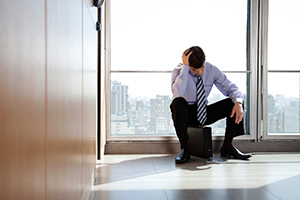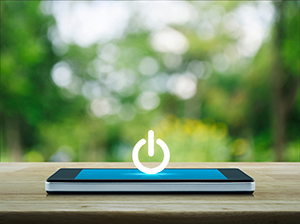Signs You May Be Heading for a Burnout and How to Prevent It
 What a year or two we have had! How are you coping with the constant unpredictability, the lack of social activities, or the children in your home office? It is possible to detect the signs of stress and burnout, and there are ways to prevent it.
What a year or two we have had! How are you coping with the constant unpredictability, the lack of social activities, or the children in your home office? It is possible to detect the signs of stress and burnout, and there are ways to prevent it.
So, what is a burnout, and what does it look like? Stressors can cause a burnout when there is an imbalance between the demands and resources.[1] Previously, stress was only looked at in relation to workplace scenarios,[2][3][4] but now we see a multifaceted construct involving emotional exhaustion, physical fatigue, and cognitive burnout [5]—the key component being exhaustion.[6][7][8][9] It is possible to evaluate someone’s stress levels through cortisol levels, a stress hormone, by doing a saliva test. Although, even with this test, it is not easy to define, as it can manifest itself in different ways with different individuals.
When our autonomic nervous system perceives danger, it sends signals to our adrenal glands, which start secreting messengers and hormones (adrenaline, cortisol, etc.) to increase energy, alertness, hearing, and sight.
When facing this acute stress and to survive the “danger,” the body redirects blood towards the brain and muscles, at the expense of digestive and reproductive organs as well as other secondary systems. This “fight-or-flight” response was ideal in hunter-gatherer times, creating sudden bursts in dangerous situations, then discharging the reaction. The difference today is that we are dealing more with a perceived danger and, instead of using this sudden burst of energy, we are just sitting at our desks.
Whether you have significant work stress, have lost a loved one, are feeling socially isolated, suffer from an illness, or simply being a parent, this response to stressors is often triggered and is very real.
A burnout—a state of advanced chronic stress defined by a decrease of daily cortisol levels—is complex and multifactorial.[10] It is defined by three components:
-
Neurological: The way we think and what we perceive
-
Physiological: The secretion of adrenaline and cortisol
-
Genetic: Our natural resilience.[11]
The length of exposure, the frequency, and the phases of stress are also important. I like to use the analogy of a car. Acute stress that creates adrenal overdrive involves revving the engine and accelerating—in this case, you are functioning on adrenaline. In an extreme situation of burnout or adrenal exhaustion, the hormonal gas tank is almost empty and you can barely get going.
Signs and Symptoms Related to Burnout
-
Sleep:[12] Insomnia, interrupted sleep, difficulty getting out of bed.
-
Mood:[13] Irritability, impatience, anger, feeling overwhelmed.
-
Depression and anxiety:[14][15] Sadness, difficulty coping.
-
Weight: Gain or loss—chronic stress often leads to weight gain in the belly.
-
Fatigue: Low energy, but initially high while functioning on adrenaline.
-
Food cravings: Desire for sweets, salty foods, and/or fatty foods.
-
Need for caffeine and stimulants.
-
Libido: Decreased sex drive.
-
Musculoskeletal: Unmotivated to exercise, heavy/tired/stiff muscles, aches and pains.[16][17]
-
Skin: Rashes, psoriasis, eczema, hair loss.
-
Immune:[18] More frequent colds, autoimmune conditions.
-
Cardiovascular:[19][20] High or low blood pressure, swelling in extremities, puffy face.
-
Mental: Difficulty with concentration/focus, escapism—frequent phone [21] or TV use, alcohol, smoking, marijuana, overeating.
-
Digestion:[22] Bloating, diarrhea, constipation, IBS.
-
Headaches [23] and migraines.[24]
-
Menstrual changes.
As we see, our entire body is involved. The solution? A holistic whole-body approach, aiming to restore physical, mental, and emotional balance.
 Exercise
Exercise
The natural response our body has to stress involves the use of our muscles, so this is an excellent way to manage stress.[25] Conversely, once you have reached a burnout, it’s often difficult to get motivated to exercise. Take it slow and listen to your body. If exercise is too intense, you will feel worse afterwards.
Breathing
Try taking a few minutes daily to connect with your breath. The idea is not to force deep or long breaths, just to consciously follow your rhythm. Any breathing technique is helpful, but my favourites are alternate nostril breathing [26] and diaphragmatic breathing. Their calming effect on the nervous system contributes to reduce the effects of stress, and it is always easier to practice these breathing techniques before stress is initiated and the “fight-or-flight” response is triggered.[27]
 Mindfulness
Mindfulness
An area of much research today, there is a lot of science behind this new trend.[28][29] The idea is being present or connecting with how you feel in the moment. In the long run, this awareness can help you to be more efficient, make clear decisions, and ask for help, which in turn prevents burnout.
Schedule in Self Time, Set Limits, and Ask for Help
Today’s society is extremely accelerated and many live on autopilot. What if we could set better boundaries and knew our limits before we reached them? Resilience, social support, and perceived organizational support are associated with less symptoms of anxiety.[30][31] To reduce the impacts of stress, slow down and add activities in your schedule that bring you joy; get together with friends and family; laugh, dance, sing; take a warm bath with Epsom salts (magnesium); give yourself a foot massage with an essential oil; or take a walk in nature or sit in a park.
 Ditch the Phone for a Few Hours Daily
Ditch the Phone for a Few Hours Daily
Frequent mobile phone use has been associated with stress, sleep disturbances, and depression, all contributing to burnout.[32] Interestingly, frequent cell-phone use was not associated with more social support.[33]
Nutrients
B vitamins, especially B5 and B6, are essential nutrients for the adrenal glands and the production of energy. Vitamin B6 is also important in serotonin production, which becomes depleted under chronic stress. Magnesium is another consideration to help with sleep and relaxation.
Remember: Prevention is key. If you are feeling any of the signs or symptoms of stress, you could well be on your way to a burnout. Try the strategies listed above and reach out for the support you need. Stay tuned for my next article on how to recover from a burnout.
 Dr. Krista Mackay, BSc, ND
Dr. Krista Mackay, BSc, ND
Krista practices both in Montreal, Quebec, and Montevideo, Uruguay. A busy mom of two boys, she focuses on naturopathic general/family medicine, helping to find a reasonable balance to optimal wellbeing and stress management, including nutrition, herbal medicine, and mind-body work.
kristamackay.ca
References
-
Salvagioni, D.A.J., F.N. Melanda, A.E. Mesas, A.D. González, F.L. Gabani, and S.M. de Andrade. “Physical, psychological and occupational consequences of job burnout: A systematic review of prospective studies.” PLoS One, Vol. 12, No. 10 (2017): e0185781.
-
Salvagioni et al. “Physical, psychological and occupational consequences of job burnout.”
-
Cyr, S., M.-J. Marcil, M.-F. Marin, J.-C. Tardif, S. Guay, M.-C. Guertin, C. Rosa, et al. “Factors associated with burnout, post-traumatic stress and anxio-depressive symptoms in healthcare workers 3 months into the COVID-19 pandemic: An observational study.” Frontiers in Psychiatry, Vol. 12 (2021): 668278.
-
Hashem, Z., and P. Zeinoun. “Self-compassion explains less burnout among healthcare professionals.” Mindfulness (2020-09-10): 1–10.
-
Jonsdottier, I.H., and A.D. Dahlman. “Mechanisms in endocrinology: Endocrine and immunological aspects of burnout: A narrative review.” European Journal of Endocrinology, Vol. 180, No. 3 (2019): R147–R158.
-
Salvagioni et al. “Physical, psychological and occupational consequences of job burnout.”
-
Cyr et al. “Factors associated with burnout, post-traumatic stress and anxio-depressive symptoms.”
-
Hashem and Zeinoun. “Self-compassion explains less burnout.”
-
Jonsdottier and Dahlman. “Mechanisms in endocrinology.”
-
Jonsdottier and Dahlman. “Mechanisms in endocrinology.”
-
Hashem and Zeinoun. “Self-compassion explains less burnout.”
-
Salvagioni et al. “Physical, psychological and occupational consequences of job burnout.”
-
Hashem and Zeinoun. “Self-compassion explains less burnout.”
-
Salvagioni et al. “Physical, psychological and occupational consequences of job burnout.”
-
Cyr et al. “Factors associated with burnout, post-traumatic stress and anxio-depressive symptoms.”
-
Salvagioni et al. “Physical, psychological and occupational consequences of job burnout.”
-
Brand, S., K. Ebner, T. Mikoteit, I. Lejri, M. Gerber, J. Beck, E. Holsboer-Trachsler, and A. Eckert. “Influence of regular physical activity on mitochondrial activity and symptoms of burnout—An interventional pilot study.” Journal of Clinical Medicine, Vol. 9, No. 3 (2020): 667.
-
Salvagioni et al. “Physical, psychological and occupational consequences of job burnout.”
-
Salvagioni et al. “Physical, psychological and occupational consequences of job burnout.”
-
Diotaiuti, P., S. Mancone, F. Bellizzi, and G. Valente. “The principal at risk: Stress and organizing mindfulness in the school context.” International Journal of Environmental Research and Public Health, Vol. 17, No. 17 (2020): 6318.
-
Thomée, S., A. Härenstam, and M. Hagberg. “Mobile phone use and stress, sleep disturbances, and symptoms of depression among young adults—A prospective cohort study.” BMC Public Health, Vol. 11 (2011): 66.
-
Diotaiuti et al. “The principal at risk: Stress and organizing mindfulness in the school context.”
-
Salvagioni et al. “Physical, psychological and occupational consequences of job burnout.”
-
Diotaiuti et al. “The principal at risk: Stress and organizing mindfulness in the school context.”
-
Brand et al. “Influence of regular physical activity on mitochondrial activity and symptoms of burnout.”
-
Kamath, A., R.P. Urval, and A.K. Shenoy. “Effect of alternate nostril breathing exercise on experimentally induced anxiety in healthy volunteers using the simulated public speaking model: A randomized controlled pilot study.” BioMed Research International, Vol. 2017 (2017): 2450670.
-
Kamath, Urval, and Shenoy. “Effect of alternate nostril breathing exercise.”
-
Hashem and Zeinoun. “Self-compassion explains less burnout.”
-
Botha, E., T. Gwin, and C. Purpora. “The effectiveness of mindfulness based programs in reducing stress experienced by nurses in adult hospital settings: A systematic review of quantitative evidence protocol.” JBI Database of Systematic Reviews and Implementation Reports, Vol. 13, No. 10 (2015): 21–29.
-
Cyr et al. “Factors associated with burnout, post-traumatic stress and anxio-depressive symptoms.”
-
Hashem and Zeinoun. “Self-compassion explains less burnout.”
-
Thomée, Härenstam, and Hagberg. “Mobile phone use and stress.”
-
Thomée, Härenstam, and Hagberg. “Mobile phone use and stress.”

 Stores
Stores